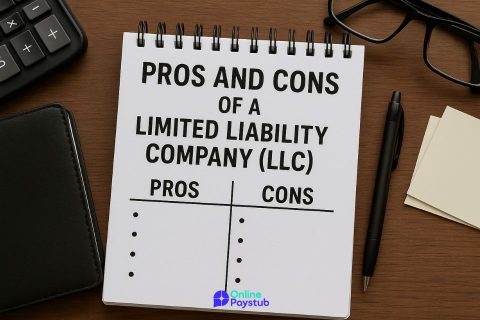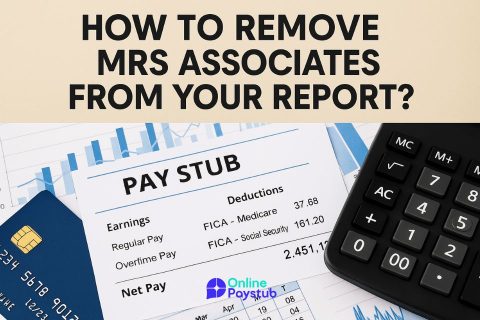In financial systems built on documentation, earning income in cash presents a clear challenge. Whether applying for a mortgage, renting an apartment, filing taxes, or proving eligibility for a visa, the lack of formal income records can quickly become a barrier. Despite this, millions of individuals including freelancers, gig workers, and domestic employees continue to earn outside traditional payroll systems.
Cash income does not inherently imply financial invisibility. What matters is whether the income can be verified. Institutions such as the IRS, banks, and property managers do not necessarily require a W-2 form; they require consistency, accuracy, and traceability in how earnings are presented.
This guide explores the most effective and accepted strategies for documenting cash-based income. It begins with one of the most reliable methods: generating your own pay stubs through online tools. From there, it examines five additional ways to establish credible financial records even without access to traditional employer-generated documents.
Method 1: Create Pay Stubs Using Online Tools
For individuals paid in cash, self-generated pay stubs can serve as a powerful first step in formalizing income records. While these documents are not issued by an employer, when properly prepared, they are widely accepted by landlords, lenders, and even some government agencies provided they reflect accurate and consistent data.
Online pay stub generators are designed to simulate the layout and detail of a traditional payroll document. Users can input their income frequency, hours worked, rate of pay, and any deductions. The final output mirrors what a regular pay stub would look like, often including tax withholdings, net income, and pay periods.
To strengthen credibility, it is recommended to use the same tool regularly and to ensure all information matches other records, such as bank deposits or income logs. Many platforms also offer PDF download options, which can be printed or emailed directly during application processes.
This method is especially useful for freelancers, domestic workers, or anyone working under verbal agreements. When paired with other forms of documentation, such as signed letters or deposit histories, online pay stubs help establish a consistent financial footprint.
Method 2: Keep a Handwritten or Digital Income Log with Consistent Entries
An income log, whether handwritten or maintained digitally, is one of the most practical ways to document cash earnings over time. This method is particularly effective for workers who receive payments daily or weekly and do not receive any formal proof of compensation.
A proper income log should include key details for each transaction: the date of payment, the amount received, the name of the client or employer, and a brief description of the service or job performed. Consistency in format and frequency is essential. A scattered or incomplete log may raise doubts, while a disciplined, structured record adds credibility.
Some individuals prefer using notebooks, but digital spreadsheets or specialized apps offer greater reliability. Digital logs can be backed up, timestamped, and even exported for tax purposes. Tools like Microsoft Excel, Google Sheets, or personal finance apps allow users to track totals and generate summaries useful when preparing for tax reporting or loan applications.
While an income log alone may not always suffice as definitive proof, when paired with supporting documents such as signed work agreements, text message confirmations, or bank deposit slips, it builds a compelling case for the legitimacy of one’s income.
Method 3: Use Notarized Income Affidavits to Support Self-Declared Earnings
A notarized income affidavit is a sworn statement in which the individual declares their earnings under oath, typically in the presence of a licensed notary public. This form of documentation is especially useful when other records are limited or unavailable.
The affidavit should clearly state the total amount earned over a defined period, the nature of the work performed, and how often payments were received. Including the names of clients or employers, locations, and dates helps enhance the credibility of the statement. Although it does not replace formal payroll documents, it adds legal weight and can be considered a supporting record in various contexts.
Some institutions, including housing authorities, government agencies, and legal offices, accept income affidavits when supported by additional evidence. This might include a detailed income log, consistent bank deposits, or signed letters from those who paid for services. In some states, income affidavits may even be used for child support calculations or applications for public benefits.
To avoid rejection, the affidavit must be truthful, specific, and aligned with other financial records. Notaries are not responsible for verifying the income itself, but they confirm the identity of the person signing and their declaration under penalty of perjury.
Method 4: Leverage Bank Deposit Records as Indirect Income Evidence
For individuals who earn in cash, bank deposit records offer a practical way to create a financial trail. Although banks do not issue income statements, a consistent pattern of deposits can serve as indirect proof of earnings, particularly when accompanied by supporting documentation.
When cash payments are deposited regularly into a bank account, they become traceable. Monthly statements reflecting these deposits can demonstrate both income frequency and stability. It is essential that deposit amounts align with reported earnings elsewhere, such as in an income log or pay stub. Discrepancies may raise concerns during financial evaluations.
To strengthen the credibility of bank deposit records, it is advisable to use the memo field to indicate the income source whenever possible. Some individuals also photograph or scan receipts or written confirmations and store them alongside digital bank statements for future reference.
This method is especially effective in scenarios involving loan applications, visa processing, or lease agreements, where financial institutions prioritize traceability. However, isolated or infrequent deposits may not be sufficient on their own. The goal is to show a reliable income stream over time, supported by consistent documentation habits.
Method 5: Request Employment Verification Letters from Cash-Based Jobs
Employment verification letters are formal statements issued by an employer that confirm an individual’s work history, job role, payment arrangement, and compensation details. For those earning in cash, especially in informal or part-time roles, these letters can serve as strong evidence of income when properly written and verified.
A complete verification letter should include the employer’s name, contact information, the employee’s full name, job title, dates of employment, hours worked, payment frequency, and total compensation. When applicable, it should also mention that the worker is paid in cash and whether the payments are regular. The letter must be printed on official letterhead if available and signed by the employer or manager.
Although not a substitute for tax documents, these letters are often accepted in rental applications, credit evaluations, and even immigration cases particularly when accompanied by other income records. If multiple employers are involved, collecting letters from each one improves the reliability of the income profile.
It’s important to ensure that the employer understands the purpose of the letter and agrees to respond to potential verification calls. Including a business card or attaching a scanned ID of the employer may increase acceptance in formal reviews.
Method 6: Present Written Service Agreements or Contracts as Proof of Income
In the absence of employer-issued pay stubs or tax forms, formal service agreements can help establish both the nature and continuity of cash income. These agreements are particularly relevant for individuals who perform recurring tasks such as childcare, home maintenance, tutoring, or freelance services under informal arrangements.
A valid service agreement should clearly outline the scope of work, duration of the arrangement, payment terms, and total compensation. Even if the payment is in cash, the presence of a signed document dated by both parties adds structure and credibility to the transaction. These contracts act as evidence of intent and ongoing professional engagement.
While many people overlook the value of a written agreement in casual work settings, even a simple contract can demonstrate financial regularity. Combined with income logs or deposit records, service agreements help verify that payments were expected, earned, and received.
In legal and financial contexts such as rental applications, child support cases, or small business audits presenting these contracts signals responsibility and transparency. Institutions often favor applicants who can document income sources through formal channels, even if those sources are outside traditional employment.




No comments to show.